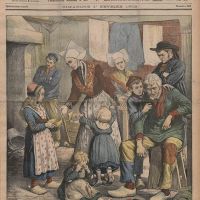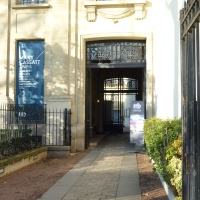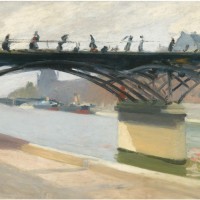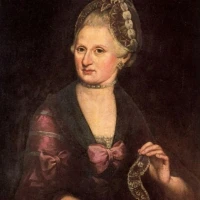It is common among Parisians and lovers of Paris to bewail the loss of the nineteenth-century market buildings at Les Halles. Those pavilions of iron, wood and glass designed by Victor Baltard stood in the heart of the city from 1857 to 1973, when they were demolished in a fit of modernizing frenzy after the market itself had moved to suburban Rungis.
The story behind the pavilions contains a few surprises, as Norman and I found out at an exhibit at the Musée d’Orsay called Victor Baltard: Le fer et le pinceau (Victor Baltard: Iron and paintbrush).
For one thing, the iron-and-glass pavilions were not the original plan for the markets. Baltard had designed something rather more traditional, capped by an iron roof but with stone walls. Construction was nearly complete on one of these buildings when in 1853 the Emperor Napoleon III decided to do a site visit. Apparently the Emperor was Not Pleased and work was halted. This was the building in question, photographed by Charles Marville.
One can just imagine Napoleon striding about the site, and Baltard anxiously following, watching as the Emperor’s frown deepens and darkens. Finally, the Emperor speaks. “This won’t do at all. You’ll have to take it down.” Or words to that effect. Not the sort of thing an architect wants to hear.
What did the Emperor want? According to Baron Haussmann, who worked closely with Napoleon III and was sensitive to his tastes, he wanted something more along the lines of the huge open trainshed at the Gare de l’Est, which had been completed a few years earlier. Haussmann quoted the Emperor as saying, “Ce sont de vastes parapluies qu’il me faut; rien de plus!” (It’s vast umbrellas that I want; nothing more!”)
Baltard’s competitors probably rubbed their hands in glee, hoping that they might have another crack at the plum assignment (Baltard was not the most popular choice for the job; to that point his résumé consisted mostly of church restorations). But after 10 days of furious rethinking, Baltard and his associate Félix Callet came back with three alternative designs, and the Emperor gave the nod to something that more closely resembled the vast umbrellas he had in mind.
The Emperor was right. The stone building that was demolished had narrow entries at the corners that would have become bottlenecks very quickly. Vast umbrellas of iron and glass would allow for much better circulation. Markets are all about circulation.
It was a fresh design, but not radical or unprecedented. The Crystal Palace at the Great Exhibition of 1851 in London had shown what was possible with iron and glass. Closer to home, the Bibliothèque Ste-Geneviève, designed by Henri Labrouste, had further demonstrated how slender iron columns could create a space with a high ceiling and plenty of room at floor level.
Baltard just needed a push to come up with the design that now seems inevitable. But once pushed, he made the most of his ideas. One could say that Baltard wrote the book on the design of market buildings, and it would not be a metaphor. He gathered his experiences into a practical guide called Monographie des halles centrales de Paris, filled with illustrations and construction details so that others could follow his lead. And one by one, new market buildings arose around the country, indeed, all around Europe, with slender iron pillars and wood-and-glass canopies. All you had to do was follow Baltard’s careful instructions, add a few tweaks and local adjustments, and voilà.
Norman and I saw one of Baltard’s children in Sens. We had gone to visit some friends who lived nearby and on a sunny Saturday morning, we wandered into the market building in the middle of town. It was an odd six-sided shape, but it was clearly in the Baltard tradition. This is a view up into the roof.
So even though the original pavilions were demolished in 1973 (the authorities carried out the dirty deed in the summer, when many Parisians were on holiday and not on hand to protest), Baltard’s children live on in hundreds of other cities and towns.
As for Paris itself, I see Baltard’s children in the iron and glass canopies over the entrances to many Paris buildings. Known as marquises (think “marquees”), these architectural umbrellas evoke Baltard for me. He didn’t invent them, of course (the connection exists solely in my imagination), but each one seems to pay a little homage to Les Halles.
Ostensibly they are there to provide shelter, but many are too small or too high to offer much protection against the rain. They are simply architectural accessories in iron and glass, the two materials that were so fashionable in the nineteenth century.
In Baltard’s day, when Haussmann was still controlling the look of Paris streets, marquises were not permitted on the exterior façades of buildings. There were found only in interior courtyards. You can still see them framing the courtyard entrances to grand buildings such as those on the rue du Faubourg St-Honoré (can you spot the marquise in this picture?).
But as the architectural controls weakened during the late nineteenth century and buildings became more flamboyant, the marquises began to venture out of courtyards and take their places on the boulevards and avenues.
There is a tiny one on the Grand Hotel des Balcons, the hotel where Norman and I stayed on our first trip to Paris together, near the Place d’Orléans. Many happy memories and associations there.
There is another on a little hotel close to the apartment where we stay these days.
Indeed, marquises seem to be de rigueur for hotels, large and small. And hotels, like markets, are all about circulation.
Many theatres have them.
But some decorate otherwise anonymous doorways.
This parasol-like version in blue is on a grand and wildly decorated building on the Avenue Marceau. This may be the entrance to the concierge’s loge.
I notice marquises wherever I go in Paris, and I’ve collected quite a few photographs of them.
I think of them as little shards of Les Halles that have scattered throughout the city to remind us of the lost mother ship.
Text and original photographs by Philippa Campsie and Norman Ball. Historical photographs from Paris en images.


































I’ve always liked those marquees too. They seem quote luxurious. I associate them with the 1920s.
One wonders where Eiffel was? There are some marvellous metal buildings in the municipal market in Manaus, in Brazil, that were designed and, I think, Made by Eiffel.
Doug Wright
In 1853, the year Napoleon III visited the site, Alexandre Gustave Eiffel was at school. Born in 1832, Eiffel was not the world’s most enthusiastic student. His tutors felt he would not get into the top school namely L’École Polytechnique but he was admitted to L’École Centrale des Arts et Manufactures and graduated in 1855. And the rest, as they say, “is history.” Soon everyone forgot, or never knew, he was not at the top of his class. Doug, thanks for your interest and question.
Those art deco forms have apparently survived in good numbers in Paris. Try finding them in Montreal!
Pingback: Les Halles and The Little Shards of Paris | FrenchNewsOnline
Iron facades were used in most American cities: Boston, New York, Chicago had/have notable ones. Pierre-henri Picq did the beautiful Schoelcher library in Martinique. It was built for the 1889 Exposition in Paris and shipped to Fort de France after the fair.
Very interesting. I would say that the marquises are just one example of how Baltard’s architecture influenced the art nouveau movement in general.
Pingback: Poulenc, the Nuns and Place de la Nation | FrenchNewsOnline
Pingback: Make do and mend | Parisian Fields